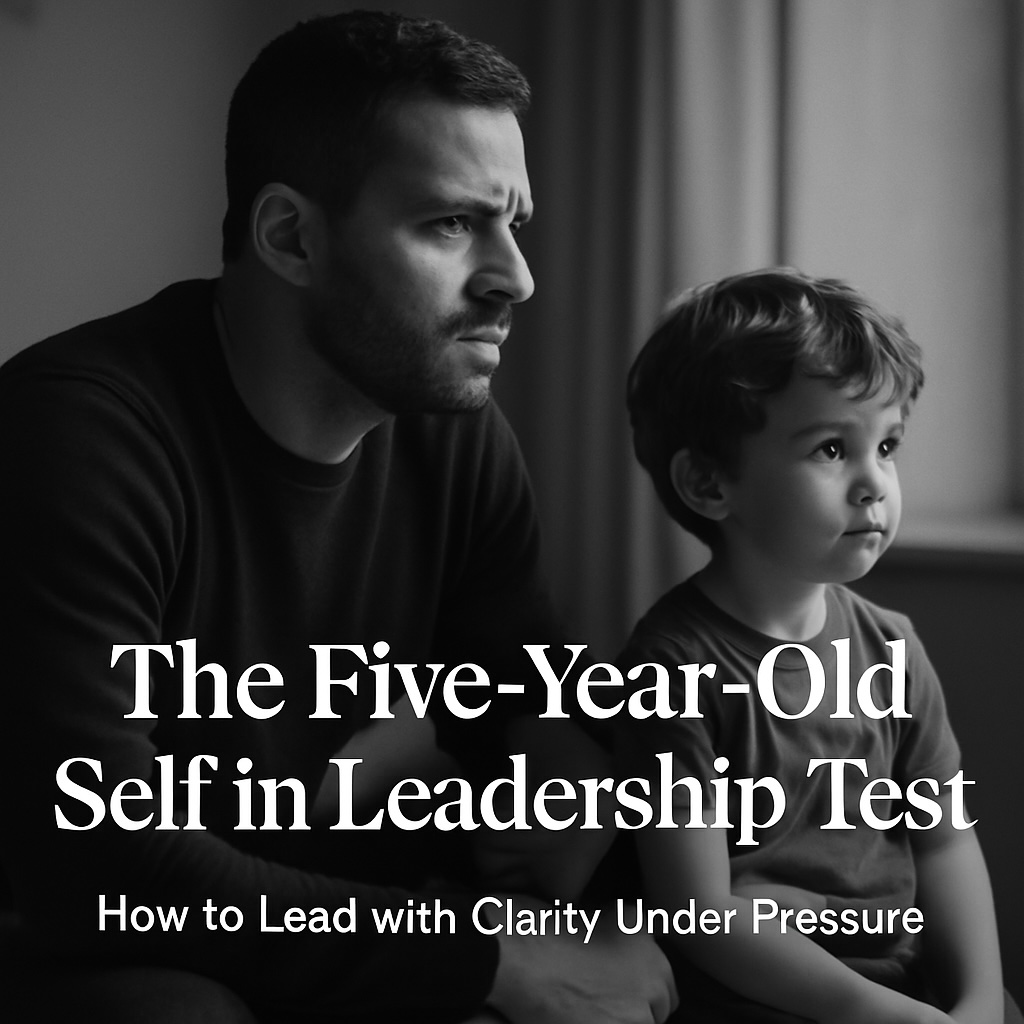The Five-Year-Old Test: When Everything’s On the Line
April 8, 2025

Why Your Five-Year-Old Self Still Runs the Show in Leadership
High-stakes moments are my bread and butter. Not because I love the pressure-but because it’s where I see the most truth. And the truth is my five-year-old self still runs the show in leadership.
Whether I’m coaching a founder walking into a board meeting, or navigating something messy in my own life, there’s one strange little habit I turn to that helps me stay grounded, connected, and not burn everything down:
I think about what I was like when I was five.
Your Five-Year-Old Self in Leadership (At Their Worst)
At my worst, I was an absolute menace. I had tantrums that could clear a room. The kind that made people uncomfortable in restaurants. I once screamed and sobbed so hard on my mother’s lap-literally pounding my fists into her chest-that I passed out. (Weird flex? Maybe. But it happened.)
It was cartoon-level drama. And while people were either horrified or secretly entertained, one thing was clear: I wasn’t someone you could trust in the heat of the moment. I didn’t have the tools. My little nervous system just short-circuited.
Your Five-Year-Old Self in Leadership (At Their Best)
But I also remember being deeply sweet. Curious. Gentle. The kind of kid who could sense when someone needed a hug, or a quiet moment, or a soft question instead of a loud answer. I wanted people to feel safe with me.
That kid is still here. So is the other one.
Why I Look Back To Move Forward
When I’m under pressure now-whether it’s a tense conversation, a make-or-break negotiation, or a moment that could change everything-I pause and ask:
- Which version of my five-year-old self is showing up?
- And which one do I want to lead with?
Because let’s be real: that five-year-old isn’t gone. They don’t retire. They just learn how to put on a collared shirt and play grown-up.
But when the stakes are high? That kid re-emerges. For some of us, it’s the tantrum thrower. For others, it’s the invisible one. Or the people-pleaser. The blamer. Or the one who needs to win.
The Tantrum Test: Leading with Your Five-Year-Old Self
This trick isn’t about inner child woo-woo stuff (though hey, if that’s your jam, carry on). It’s about data. Behavior under stress is one of the most predictable and revealing things about us. And if you’ve ever acted in a way that surprised even you-snapped at someone, shut down, over-explained, or overcompensated-you know what I mean.
Thinking about your five-year-old self gives you a shortcut to the root. It helps you understand what others might be experiencing in you. It gives you a moment to pause and ask: Do I want to win this moment, or do I want to protect the relationship? Do I want to act from strategy, or from survival?1
When Your Five-Year-Old Self Shows Up in Leadership
This isn’t just cute. It’s useful. I teach this to my clients not because it’s adorable, but because it’s effective. It disarms defensiveness, brings humor into intensity and softens power dynamics. It gives language to something that feels chaotic. And it works just as well in the boardroom as it does at home.2
You don’t need to fix your five-year-old self. But you do need to know who they were-and how they show up under pressure.
Because when the stakes are high, it’s not just about what you say. It’s about who’s doing the talking.
The Leadership Parallel
Whether you’re leading a company, a team, or just trying to hold your own in a hard conversation-your stress response matters. It’s not enough to master the talking points. You have to master the energy behind them. And that energy is usually shaped by experiences much earlier than you think.
Getting honest about who you become under pressure isn’t just about self-awareness. It’s about strategy. Because if you want to show up effectively, you’ve got to know what parts of you are driving the car.
And often, it’s your five-year-old self in leadership that’s got their hands on the wheel.3
Final Words
Got a high-pressure moment coming up? Try the five-year-old test. It might not fix everything, but it might just give you a beat to choose differently.
Pardon the plug: At Hiddn, this is the kind of behavior-focused coaching we build with leaders who are ready to lead with clarity, not chaos.
Another plug: If you’re tired of stress making your decisions for you, we should talk.
Last plug, I promise: If your five-year-old is still running the show, we can help them take the day off.
Be the first to comment